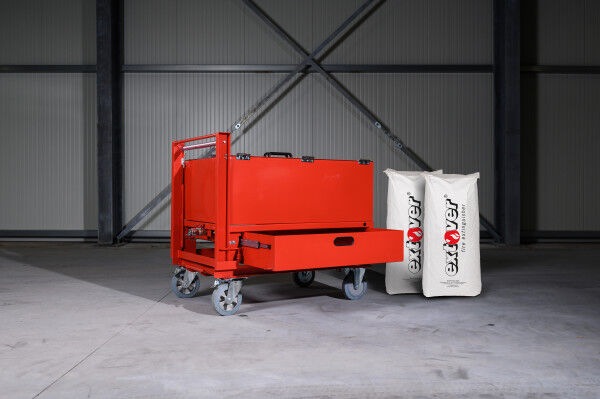incl. VAT.
Please note: Notes on delivery time
Free shipping (Germany, mainland)!
Shippingtime: ca. 10 Wo.
- Article no: PMSHACHAVRC

Questions about the article?
Our staff member Petra Fürbeck is happy to help you:
+49 (0) 7151 - 256 4817 or info@lion-care.com
| Handling the filling material: | Fire protection bag, Backfill |
| Empty weight: | approx. 295 kg |
| Volume: | 940 liters |
| External dimensions: | 1200 x 800 x 983 mm |
| Filling material: | Extover extinguishing granules, Fire protection bag |
| Internal dimensions: | Tub: 1109 x 778 x 420 mm, Drawer: 788 x 955 x 185 mm |
Lithium batteries are not only used in electric cars from OEMs, but also in industrial trucks with electric drives, which are becoming increasingly common in corporate logistics. Lithium-ion batteries have also become indispensable in all other applications.
MÜLLER HAVARIE ROLLCONRAINER - Immediate hazard prevention for conspicuous lithium batteries.
In the event of conspicuous batteries, the emergency container is a tool that can be used immediately on site. Thanks to its easily accessible front and dome flaps, the damaged battery can be quickly loaded into the container. The closed container ensures a controlled reaction of the energy storage unit. This system is a compact solution and is suitable for almost all locations. Examples include retirement homes, hospitals, administrative buildings and industrial operations. The roll containers can be easily integrated into existing logistics concepts and fit seamlessly into existing buildings, not least thanks to their design in accordance with AGBF recommendations.
Technical features and dimensions
The container has a length of 1200 mm, a width of 800 mm and a height of 983 mm. The width of the tray inside the container is 778 mm, the length 1109 mm and the height 420 mm. The drawer has a length of 788 mm, a width of 955 mm and a height of 185 mm.
Functions and equipment
The emergency container is designed for multiple use and is suitable for dry and wet quarantine conditions. Damaged battery modules can be monitored in the container without it necessarily having to be filled with water. Two dome flaps attached to the top of the container can be opened to the sides. After loading, the flaps are closed and the trolley with the damaged goods can be taken a short distance outside. A pressure relief valve in the dome flap ensures that there is no overpressure in the interior and that the pressure is released in a controlled manner. If the situation allows, the battery can be packed into the integrated fire bag beforehand.
Incl. Storz-D water connection for flooding the container
The container can be filled with extinguishing water via integrated filling devices until the battery is completely covered. The water can then be drained via a ball valve fitted near the bottom. If necessary, contaminated water can be drained off via a drain and disposed of properly.
Incl. 6 bags of Exotver dry extinguishing agent made from expanded glass granulate
The container can also be filled with 6 Extover fire extinguishing agent bags of 55 liters each. The Extover extinguishing agent is a special fire extinguishing agent made of expanded glass, which is non-flammable. It is reusable and recyclable and also environmentally friendly. The extinguishing agent displaces oxygen and thus helps to smother the fire, while also binding gases and vapors, which enables environmentally friendly disposal.
Specially designed fire protection bag provides additional safety and is included in the set
There is also a fire protection bag of the Akkusafe type, which is specially made for the container. The bag body is made of Bagtex, a special material that releases moisture inwards when heat builds up, thus providing additional cooling. The body of the bag is partly made of Flotrex (glass fiber reinforced aramid fabric with stainless steel and reinforced on the inside with fire-retardant fabric). This material serves as an inflation window to allow the bag to deflate in the event of an emergency.
Safe handling of emergencies with emergency containers. Quick separation of damaged or reactive batteries
Paul Müller Safety emergency containers were originally developed for use in production lines in the automotive industry. They have proven their worth there over the years with various manufacturers. With the advent of electromobility and the use of high-performance lithium batteries in various industries, the emergency containers have now also established themselves in logistics centers, warehouses, shipyards, commercial vehicle workshops, bus depots and hospitals.
Customized solutions for every industry
The container is suitable for use in a wide range of industries and areas of application, which we would like to discuss below:
Industrial companies
The emergency containers have already proven themselves for many years in the production lines of car manufacturers. This product development was created in direct response to demand from the automotive industry and is based on experience with hazardous goods load carriers already in use for the safe transportation of lithium batteries.
Logistics centers, freight terminals and warehouses
Packages, palletized goods and stored goods increasingly contain lithium energy storage systems. Accidents and incidents involving lithium batteries occur time and again during storage, reloading or order picking. This emergency container is set up in logistics centers, high-bay warehouses and freight terminals.
Workshops for buses and commercial vehicles / vehicle depots
Electric and hybrid buses, fully electric trucks and electric fleet vehicles are regularly serviced and maintained in garages, bus depots and by vehicle manufacturers. The large-volume breakdown containers are often used for other purposes and serve as temporary storage for expanded battery storage systems.
Shipbuilding
Yachts, car ferries, excursion boats, cargo and cruise ships are increasingly being equipped with large-volume lithium battery storage systems for auxiliary propulsion or even as a primary energy source. Batteries are installed, removed, transported and serviced during the initial fitting and subsequent maintenance work in the shipyard.
Certified quality from Germany
The containers are fully developed, manufactured and tested in Germany and meet the highest quality standards.
Fire and drop tests for the optimum solution
The durability and longevity of the container results from the selection of the right materials and components. New developments are tested for their suitability in practical use in fire and drop tests. Our own fire testing facility enables tests to be carried out in accordance with BAM specifications. Consistent quality management ensures consistent processes. Paul Müller GmbH has certifications in accordance with DIN EN 14001, DIN EN 9001, IBE-BVI, EN 1090-1 in conjunction with EN 1090-2 EXC 3 and TISAX approvals. Both series products and custom-made products are subjected to a visual inspection, a functional test and a leak test before delivery.
PAUL MÜLLER SAFETY - Special solutions for demanding requirements
Paul Müller Safety stands for tailor-made solutions that are specially designed for challenging tasks. The company offers a wide range of products tailored to the needs of fire departments, rescue companies and disaster control.
The requirements for handling electric vehicles and battery storage systems are becoming increasingly complex and diverse. Paul Müller Safety is a leading specialist in the safe transportation and storage of damaged electric vehicles and large batteries. Paul Müller Safety's products play a crucial role in the management of large transportation tasks and efficient logistics in day-to-day operations.
The company has developed specially adapted products for both fire departments and disaster control that meet the requirements of these areas of application. Products have also been developed to meet the specific needs of towing and recovery companies. Paul Müller Safety's many years of experience and comprehensive expertise enable it to offer innovative solutions that meet the highest standards in terms of safety and efficiency.
Future-oriented
Lithium-ion batteries will be indispensable in all industrial applications in the coming years. However, if used improperly, batteries can pose a potential hazard during production, storage and transportation that should not be underestimated. By purchasing these boxes, you protect yourself against major financial losses right from the start. International customers from the automotive and energy supply sectors, among others, rely on this proven technology.
In use for you
If you have any questions, please do not hesitate to contact us. We look forward to hearing from you.
| Handling the filling material: | Fire protection bag, Backfill |
| Empty weight: | approx. 295 kg |
| Type: | Recovery system |
| Material: | Steel |
| Type of packaging: | Recovery systems |
| Volume: | > 600 l |
| Filling material supplied: | Expanded glass granulate (bulk material) |
| Volume: | 940 liters |
| External dimensions: | 1200 x 800 x 983 mm |
| Filling material: | Extover extinguishing granules, Fire protection bag |
| Internal dimensions: | Tub: 1109 x 778 x 420 mm, Drawer: 788 x 955 x 185 mm |
PRODUCT FILM - MÜLLER ROLL CONTAINER HAVARIE
That depends on various factors that need to be considered:
- size of the battery(ies)
- condition (e.g. non-critical, defective, critically defective or prototype)
- power
Transport boxes are available in many different sizes and specifications. The packaging group for which the box is suitable is indicated for each product.
Find out more in our blog article:
https://www.lion-care.com/aktuelles/blog/transportvorschriften-regeln-und-sicherheitsmassnahmen
Even if the batteries are not critical, remember to protect them from shocks and to order appropriate filling material if it is not already included in the box.
Yes. Should a battery reach a critical state and cause a fire, separating the batteries will prevent the fire from spreading and multiplying.
Generally, the insulation and protection material should line all sides of the container. The batteries are stored between individual layers.
We also have containers in our program that already have the protective material integrated into the outer wall. No further protective layer is necessary here.
The technical principles for storage and transportation solutions are very similar. The transport boxes are also subjected to extensive tests in accordance with ADR (drop test, fire test, etc.) to confirm compliance with the ADR regulations. The packaging regulations are extensive and regulated by law.
There are currently no comparable regulations for storage. Nevertheless, manufacturers of storage boxes regularly carry out appropriate tests.
The right container depends on the type and size of the battery to be shipped or stored.
If you want to learn more about battery storage and transportation, you will find the answers in our blog articles:
https://www.lion-care.com/aktuelles/blog/transportvorschriften-regeln-und-sicherheitsmassnahmen
https://www.lion-care.com/aktuelles/blog/lithium-ionen-akkus-sicherer-umgang-und-richtige-lagerung
The transportation of batteries is subject to ADR regulations.
The number, size and weight, energy density and condition of the batteries are crucial parameters for finding a suitable transport container for lithium-ion batteries. The selection process is complex and should be carried out by appropriately trained personnel. We have a trained hazardous materials officer on our team. Please feel free to contact us.
Plastic containers are cheaper but not as durable as metal containers. They are suitable, for example, for non-critical batteries, defective batteries, prototypes and end-of-life batteries. They can be used for both storage and transportation.
Metal containers are required, for example, when dealing with critically defective batteries.
The exact packaging instructions for these cases can be found in the ADR or by consulting a certified hazardous materials specialist.
To date, there are no legal requirements for the storage of lithium-ion batteries, which does not mean that they should be stored without suitable protective measures.
It is best to check with your insurer to find out which measures they recognize as suitable in the event of a claim.
For example, a suitable box could already be recognized as spatial separation.
A rough overview can be found in this VDS publication from the GDV:
https://shop. vds.de/download/vds-3103/ccb1d439-ad9d-47cb-a2b1-ace23e155610
Please also read our blog article on this topic:
https://www.lion-care.com/aktuelles/blog/lithium-ionen-akkus-sicherer-umgang-und-richtige-lagerung























